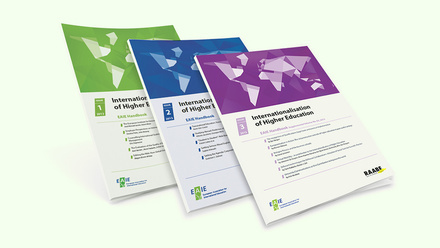5 steps to an aligned internationalised curriculum

Educational design is often based on the principle of constructive alignment. When designing internationalised curricula, the alignment across student learning outcomes, their assessment and the teaching and learning activities is even more critical and challenging. In this blog we consider why constructive alignment matters in curriculum internationalisation, and we present five important steps to consider in this process.
Constructive alignment connects the constructivist approach to teaching and learning with the principle of curriculum alignment. Constructivism is the idea that students ‘construct’ meaning through relevant learning activities; in other words, meaning is not transmitted from teacher to learner, but rather is created by learners themselves. The 'alignment' aspect refers to what the teachers do: namely, they create a learning environment with learning and teaching activities through which the desired learning outcomes are achieved. In such an aligned learning environment, the learning activities support the learners in achieving the intended learning outcomes, which they demonstrate in assessment tasks that are appropriate for the evaluation of the intended learning.
Hence, a constructively aligned internationalised curriculum involves the purposeful, comprehensive and systematic inclusion of international and intercultural dimensions in the entire study process. This includes the following aspects:
- Articulation of the intended internationalised learning outcomes;
- Planning of teaching and learning activities with appropriately chosen learning materials, contents and literature which include international and intercultural perspectives;
- Assessment of the intended learning outcomes with explicit assessment criteria of the international or intercultural dimensions; and
- Defining the ‘long-term impact’ on the student development and linking this to the graduate attributes, such as the development of intercultural competence, transferable and employability skills, or global citizenship.
When programme teams engage in the process of internationalising curricula, constructive alignment is often absent or incomplete. Simply adding or infusing random internationalised elements, such as a COIL project or electives, is insufficient to internationalise an entire degree course; yet, this is what often happens in practice. In order to successfully internationalise curricula, we need to move beyond such a fragmented and activity-based approach and aim for constructive alignment within teaching units and across the degree programme.
The key to internationalising curricula is intentionalising what is already present in our learning environments
The good news is that there are probably already many opportunities for aligning curriculum internationalisation present in your context. Below are five crucial steps to take for an internationalised and aligned curriculum.
1) Recognise and embed global/international/intercultural dimensions in learning outcomes
In practice it often happens that the student learning outcomes do not reflect (or at least not explicitly) any international or intercultural dimensions. Yet despite this absence, these elements do often spontaneously occur in teaching and learning practices.
For instance, in the classroom you may ask students to evaluate a situation, an issue or a problem from multiple cultural perspectives. Surely, you would expect students to learn something from this activity, but if it is not captured in a learning outcome and assessed, students may not be aware of what it is they are learning through this. So recognise what it is you are already doing and gain inspiration from readily available descriptors of international, intercultural and global competences such as the Nuffic model of international competences, ICOMS and the VALUE rubrics from the AAC&U; this can help you give words to what you are already doing and support you in making the international dimension explicit.
2) Consider who is in your classroom: mind the gap
The diversity of learners in our classrooms challenges lecturers to design appropriately structured learning activities that support the development of intercultural competence and international perspectives. There is a wide variety of instruments that can be used to internationalise teaching and learning, such as guest lectures from local cultural groups; international companies or international partner universities; working with local cultural, ethnic, religious or international communities; as well as including comparative international literature, content and case studies.
However, given the heterogeneous nature of our international student population as well as our domestic student groups, lecturers need to be much more aware of the backgrounds of their learners in terms of prior knowledge and experiences, learning strategies and academic preparation and expectations. Making sure that students are prepared and equipped to successfully engage with the learning activities we have planned is key to students’ academic success. This can mean that classroom activities need to be scaffolded, moving from less challenging to more challenging tasks. For instance, make sure you give students thinking time, as not everyone may be as fluent in the language of instruction. Have students pre-discuss in pairs before a plenary discussion and present new information in different modalities: in speech, writing, video or visuals.
3) Tap into ‘global knowledge pluralism’ and uncover other knowledges
In an internationalised curriculum, connections between international and intercultural perspectives, standards and examples from across the globe are explored, and the selected literature and case studies need to invite comparative analysis and engaging discussions. However, there is often unconscious bias involved when selecting course materials as various factors play a role, such as the academic discipline, cultural preferences, availability of resources in the language of instruction and lack of international awareness on the part of the lecturer. Often this results in a syllabus in which Western literature and paradigms dominate and where the written word is valued over other ways of expression.
Such unintentional bias is part of the hidden curriculum, which signals whose knowledge and whose perspectives have power and take precedence over other voices. The presence of the diverse perspectives that our learners bring with them into the classroom presents opportunities for internationalising the syllabus on the one hand, yet, on the other hand, the lack of connection and alignment with other knowledges and experiences can turn the diverse classroom into a single-sided story or even an alienating experience. Tap into this plurality of knowledges by, for example, making students responsible for sourcing and describing case studies utilising their cultural backgrounds.
4) De-culturalise assessment
In an internationalised curriculum, objective assessment and evaluation activities play an important role: they are performed objectively, when the final grade only depends on the subject matter without being affected by external factors, like the characteristics of an assessor or the characteristics of the person that is assessed or the assessment situation. Assessment is always a social situation, especially when it is carried out orally or when it includes complex assessment forms, like essays, practical tasks, project work or student portfolios.
Assessment should not be a test of culture, but a test of student learning
In a multicultural learning environment the assessment tasks should be carefully considered, as well as the potential cultural bias in the task and the assessor. Besides including explicit assessment criteria that specifically reward international or intercultural perspectives, a variety of assessment methods should be used to allow students from diverse backgrounds to demonstrate their range of intercultural and/or international abilities. In particular, lecturers need to be mindful that the assessment tasks and/or criteria should avoid specific cultural knowledge needed to complete a task, and that a fine balance between assessing language and content must be drawn. In other words, the assessment should not be a test of culture, but a test of student learning.
5) Align for impact
In an aligned internationalised curriculum, students can develop specific intercultural and international skills and knowledge, whether that is being able to effectively perform in intercultural situations relevant to academic discipline and practice, acquiring and using knowledge in and across disciplines, or considering the global application and impact of specific course content on disciplinary knowledge. Such a curriculum can foster students’ intercultural mindset and employability skills, and their international and global perspective as a long-term outcome or impact of the internationalised curriculum, which has been highlighted by many authors and studies.
This kind of student development cannot happen through a single module; rather this should be continuously and progressively addressed throughout a degree course. In essence, constructive alignment happens both within a module and within an entire degree course, by connecting modules to the programme learning outcomes, building a logical sequence and matching the needs of the society and the field of work.
The key to internationalising curricula is intentionalising what is already present in our learning environments, and constructive alignment helps us create a coherent and cohesive learning experience for all our students.






